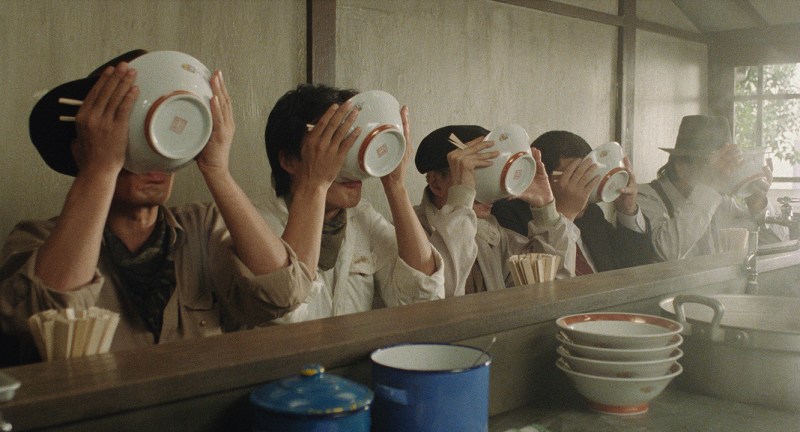Watching Juzo Itami’s 1985 film “Tampopo,” now gorgeously restored and back in theaters courtesy of Janus Films, I was reminded of a near contemporaneous Stephen Sondheim song, “Putting It Together.” In it, Sondheim muses that “the art of making art is putting it together, bit by bit.” I found myself applying those words not to the creation of painting, sculpture, music, or dance, but to ramen noodles. In “Tampopo,” Itami does not just construct a loving homage to this staple of Japanese cuisine, but uses ramen to explore our identities and relationships with food.
The titular character of “Tampopo” is the proprietor of a provincial ramen shop, and she is a competent enough cook — her pickles are supposed to be delectable. Still, her signature ramen dish is in need of improvement. The broth is watery, the noodles are undercooked, and the pork is cut too thick. Tampopo has always dreamed of opening a real ramen shop, and luckily, two truck drivers who consider themselves experts in ramen agree to help her achieve her goal. Little by little, they “put it together” like any visual or performing artist. They find the optimal broth recipe, perfect the noodles, speed up the service, and remodel the décor of the shop. Itami’s camera lingers over each dish Tampopo makes on her quest to culinary stardom. The ramen Tampopo serves does not resemble those caloric, ninety-nine cent instant abominations in the least. This ramen is an expertly executed experience, and it makes our mouths water.
This basic plot summary can make “Tampopo” seem like either a ramen-infused Horatio Alger story or a banal Food Network program, but there really is no way to capture the idiosyncratic structure of “Tampopo.” The film detours from Tampopo’s story to present a plethora of anecdotes. Itami tells of a woman who rises from her deathbed to cook dinner for her family, of a pesky old lady who squeezes and damages food in a supermarket, and of a couple who use food to fill essential roles in their erotic escapades. We are witness to a class about the proper way to eat noodles and to a painful dental operation.
These episodes sometimes appear out of nowhere, but they never detract from the narrative. Instead, they call our attention to the versatile and sophisticated relationships we have with what we eat. Food does not just nourish us. It can also arouse us, embarrass us, and instruct us, and it is central in both times of grief and joy. These disparate tales suggest the diverse applications of cuisine.
Itami focuses on ramen in particular as a multifaceted and nuanced dish. Ramen is not only an art, but it is also a ritual. To eat ramen properly, one must follow a strict order and series of steps. Itami illustrates these guidelines meticulously, and at times, it seems that the rules for eating ramen are just as complex as those for performing a religious ceremony. And in fact, for centuries, Japanese society was defined by ceremony. The legendary samurai themselves were noted for their adherence to a strict code of honor. By equating ramen with these ancient rituals, Itami suggests that this dish is more than just delicious. It is central to Japanese identity.
Furthermore, ramen is populist. At one point in the film, Tampopo goes into her competitors’ restaurant and denounces their ramen as amateurish. When they balk at her remarks, Tampopo responds that we are all amateurs when it comes to eating ramen. Even if the ramen in Itami’s film is more gourmet than what one would find at an American supermarket, it is still a food of the people. Indeed, one of Itami’s anecdotes pokes fun at a group of Japanese businessmen while they order food. They all want to try foreign items, but they overlook the true delight of ramen.
Itami has called “Tampopo” a “ramen western,” a play on the term “spaghetti westerns.” The passion that the characters carry for ramen is as intense as the greed the bounty hunters and cowboys feel in a film like Sergio Leone’s “The Good, The Bad, and The Ugly.” Itami’s striking close-ups and Kunihiko Murai’s lively score do suggest the spaghetti western aesthetic. However, Itami also draws from the comedy of Jacques Tati in creating the haphazard, random structure of the film. I found references to Hiroshi Teshigahara’s “Woman in the Dunes” in Itami’s sensual scenes, and his images of intrepid truck drivers recall Henri-Georges Clouzot’s “The Wages of Fear.” All in all, the film is a smorgasbord of cinematic influences. Just as the characters in the film put the ramen recipe together, Itami himself makes art by “putting it together,” synthesizing these visual homages with his own quirky mise-en-scène and his desire to pay tribute to ramen.
In the film, the way for us to tell whether Tampopo’s ramen is successful is if all of her customers completely drain the bowl of broth. Tampopo is not just endeavoring to make good ramen — she strives to cook ramen that forces her patrons to reconsider what ramen is and make them feel ashamed they have allowed themselves to eat lesser ramen dishes for years. Itami’s “Tampopo” does for cinema what Tampopo’s cooking does to ramen. As I viewed “Tampopo,” I found myself reflecting on my relationship with what I eat. Itami highlights the complexities of cuisine so well I felt embarrassed that I had let myself watch so many hackneyed cooking shows.
When I received the assignment to review “Tampopo” for the Daily, I was a little apprehensive. I am indifferent to ramen, and I wondered if someone with greater enthusiasm for the dish should review Itami’s comedy. But fellow ramen-skeptics can rest easy. Itami’s musing on food and filmmaking is so zany, so irreverent, so heart-warming, and so entertaining that even I felt compelled to dig in and drink to the last drop.
Contact Amir Abou-Jaoude at amir2 ‘at’ stanford.edu.
